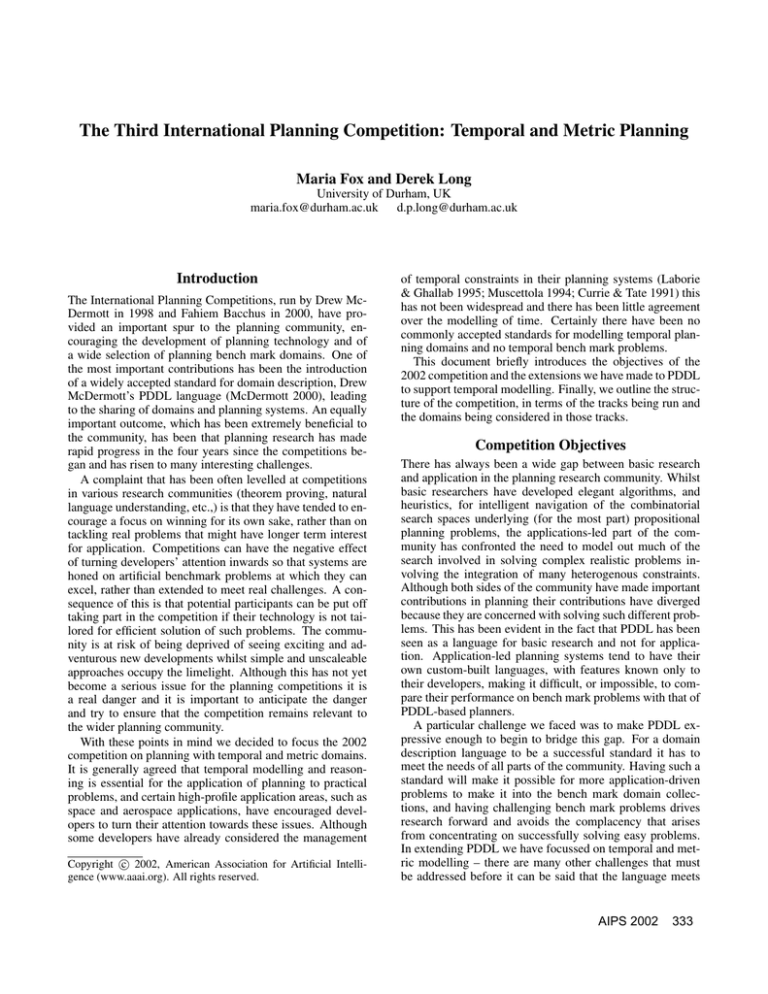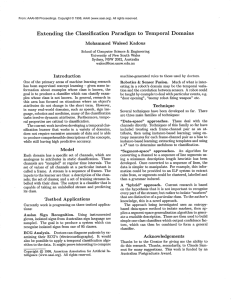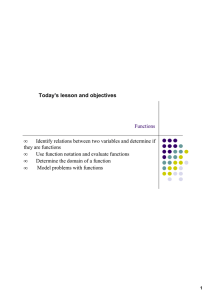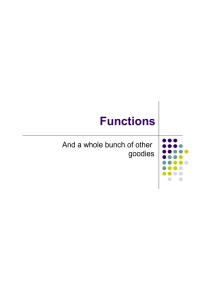
The Third International Planning Competition: Temporal and Metric Planning
Maria Fox and Derek Long
University of Durham, UK
maria.fox@durham.ac.uk d.p.long@durham.ac.uk
Introduction
The International Planning Competitions, run by Drew McDermott in 1998 and Fahiem Bacchus in 2000, have provided an important spur to the planning community, encouraging the development of planning technology and of
a wide selection of planning bench mark domains. One of
the most important contributions has been the introduction
of a widely accepted standard for domain description, Drew
McDermott’s PDDL language (McDermott 2000), leading
to the sharing of domains and planning systems. An equally
important outcome, which has been extremely beneficial to
the community, has been that planning research has made
rapid progress in the four years since the competitions began and has risen to many interesting challenges.
A complaint that has been often levelled at competitions
in various research communities (theorem proving, natural
language understanding, etc.,) is that they have tended to encourage a focus on winning for its own sake, rather than on
tackling real problems that might have longer term interest
for application. Competitions can have the negative effect
of turning developers’ attention inwards so that systems are
honed on artificial benchmark problems at which they can
excel, rather than extended to meet real challenges. A consequence of this is that potential participants can be put off
taking part in the competition if their technology is not tailored for efficient solution of such problems. The community is at risk of being deprived of seeing exciting and adventurous new developments whilst simple and unscaleable
approaches occupy the limelight. Although this has not yet
become a serious issue for the planning competitions it is
a real danger and it is important to anticipate the danger
and try to ensure that the competition remains relevant to
the wider planning community.
With these points in mind we decided to focus the 2002
competition on planning with temporal and metric domains.
It is generally agreed that temporal modelling and reasoning is essential for the application of planning to practical
problems, and certain high-profile application areas, such as
space and aerospace applications, have encouraged developers to turn their attention towards these issues. Although
some developers have already considered the management
c 2002, American Association for Artificial IntelliCopyright gence (www.aaai.org). All rights reserved.
of temporal constraints in their planning systems (Laborie
& Ghallab 1995; Muscettola 1994; Currie & Tate 1991) this
has not been widespread and there has been little agreement
over the modelling of time. Certainly there have been no
commonly accepted standards for modelling temporal planning domains and no temporal bench mark problems.
This document briefly introduces the objectives of the
2002 competition and the extensions we have made to PDDL
to support temporal modelling. Finally, we outline the structure of the competition, in terms of the tracks being run and
the domains being considered in those tracks.
Competition Objectives
There has always been a wide gap between basic research
and application in the planning research community. Whilst
basic researchers have developed elegant algorithms, and
heuristics, for intelligent navigation of the combinatorial
search spaces underlying (for the most part) propositional
planning problems, the applications-led part of the community has confronted the need to model out much of the
search involved in solving complex realistic problems involving the integration of many heterogenous constraints.
Although both sides of the community have made important
contributions in planning their contributions have diverged
because they are concerned with solving such different problems. This has been evident in the fact that PDDL has been
seen as a language for basic research and not for application. Application-led planning systems tend to have their
own custom-built languages, with features known only to
their developers, making it difficult, or impossible, to compare their performance on bench mark problems with that of
PDDL-based planners.
A particular challenge we faced was to make PDDL expressive enough to begin to bridge this gap. For a domain
description language to be a successful standard it has to
meet the needs of all parts of the community. Having such a
standard will make it possible for more application-driven
problems to make it into the bench mark domain collections, and having challenging bench mark problems drives
research forward and avoids the complacency that arises
from concentrating on successfully solving easy problems.
In extending PDDL we have focussed on temporal and metric modelling – there are many other challenges that must
be addressed before it can be said that the language meets
AIPS 2002
333
the needs of all parts of the community but we think that the
extensions we have made constitute an important first step.
We hope that the competition will precipitate a burst of
activity in temporal and metric planning which will help to
close the gap between the theory and application of planning
and to raise the expectations and ambitions of the planning
research community.
PDDL2.1
In order to support the objectives outlined above we developed a series of extensions to the domain description standard PDDL. These mainly comprise temporal extensions –
in particular the ability to express durative actions supporting both discrete and continuous temporal modelling. The
most adventurous temporal extension we made models actions with delayed effects in terms of the instantaneous initiation and termination of processes, active on numeric state
over continuous intervals of time. This extension constitutes
such a radical departure from the commonly adopted temporal modelling approaches in which actions, rather than state,
have duration that there has not been time for it to be sufficiently widely adopted to justify its use in the competition.
However, this extension, which we refer to in the following
paragraphs as level 5, we consider to be a philosophically accurate model of how state changes over time. It has a direct
relationship with timed hybrid automata theory (Henzinger
1996), which we used to provide the formal semantics, making it capable of modelling complex domains with discrete
(logical) and continuous (numeric) elements.
In addition to providing several temporal extensions we
tidied up some of the syntax already present in PDDL for
modelling metric quantities such as consumable resources.
The extended language is called PDDL+.
As mentioned above, PDDL+ comprises five levels, the
first four of which constitute the officially agreed extensions
to PDDL for use in the 2002 competition. We refer to these
four levels as PDDL2.1. The full details of PDDL2.1 and
PDDL+ are given in (Fox & Long 2001b). Level 5 and its
formal semantics are described in (Fox & Long 2001a).
The five levels of PDDL+ are organised in the following
way. Level 1 corresponds to the propositional and ADL
levels of McDermott’s PDDL. Nothing new is added or
changed, ensuring backward compatibility with the previous language standard. Level 2 supplements level 1 with
numeric variables and the ability to test and update their
values instantaneously, and represents a minor revision of
McDermott’s proposals (McDermott 2000). Levels 3 and 4
contain durative actions – actions the effects of which occur
some time after the instant of their execution. Level 3 durative actions discretize time, whilst level 4 durative actions
can have continuous effects. Because durative actions allow
only restricted access to the states of the variables they affect, level 4 simplifies the modelling of real time domains.
Level 5 is a natural extension of level 4 and presents a way
forward for the design of an expressive planning domain
description language, capable of representing arbitrary real
time, mixed discrete/continuous domains. All levels constitute completed languages with formal semantics and provide
334
AIPS 2002
a strong foundation for further development of the PDDL sequence.
One of our objectives in extending PDDL has been to supply a means by which more interesting plan metrics than
plan length can be used to judge the value of a plan. The use
of numbers in a domain provides a platform for measuring
consumption of critical resources and other parameters. An
example of a metric we can now model is that fuel use must
be minimized or that overall execution time must be minimized, or both (and other such mixed-objective examples).
Durative Action Semantics
A very important extension introduced in the durative actions modelling at levels 3 and 4 is the ability to associate conditions and effects with the end points of durative actions. A common approach (Smith & Weld 1999;
Haslum & Geffner 2001; Bacchus & Ady 2001) to durative action modelling has been to treat them as indivisible
units with preconditions that must remain true throughout
their intervals of execution and effects that are undefined until these intervals are complete. This modelling unnecessarily prohibits much of the interesting concurrency that might
be exploited in a domain. When conditions and effects are
associated with the two end-points there is more scope for
interleaving of actions and thereby exploiting concurrency.
Conditions that must in fact remain true throughout the interval of execution of an action can be handled separately
as invariant conditions, providing greater flexibility in the
modelling process.
The view of a durative action having end points derives
from our philosopical position on whether actions or states
have duration. In our view, logical change must be instantaneous and only numeric values can be updated continuously. When a durative action is applied it changes logical
state and initiates a period of time within a state that might
be subject to numeric update. When that period has elapsed
a new logical state is entered. Our durative action syntax
at levels 3 and 4 are simplified versions of level 5 in which
time is discretized in various ways. We see levels 3 and 4 as
progressive stages in the development towards level 5, not
as alternatives to the modelling approaches used in level 5.
Of course, the implementation of these semantics is a matter
for the planners handling levels 3 and 4.
Associated with the semantics of the actions is the question of plan validity. When the view is taken that actions
have two instantaneous end points, decarmating a period of
time in a state, the question arises under what circumstances
two actions can overlap. In a direct implementation of our
semantics two actions with mutually inconsistent end-points
can overlap if their end points do not occur simultaneously.
A plan that allows two conflicting end points to co-occur is
therefore invalid, whilst one that allows a tiny fraction of
time to elapse between the occurrences of these end points
is valid. The way we determine the size of this fraction of
time is to provide it as part of the domain specification and
to validate plans by ensuring that at least this fraction is used
to separate mutually exclusive action end points. This complication, which is a natural consequence of the semantics of
concurrent activity, modifies the construction of valid plans
in a way that must be observed by all competing planners.
Tracks and Domains
As in previous competitions we have operated two tracks in
the competition: the fully automated and hand-coded tracks.
Within each of these tracks we have operated five different levels of complexity from STRIPS through to complex
domains involving numeric quantities and continuous time.
Whilst some of the domains are similar in style to the classic
bench marks (the DriverLog, Depots and Zeno Travel domains), others have been deliberately designed to appeal to
the more applications-led part of the community (the Satellite, Mars Rovers and Relief Mission domains). Still other
domains were designed to combine the features of classic
bench marks in a way that makes them much more challenging. For example, DriverLog combines a version of the
classic Logistics domain with the need to allocate drivers to
the trucks. This simple combination results in a very challenging domain.
At the time of writing, interesting challenges await us in
interpreting and presenting the results of the competition.
Planners in the hand-coded track might well display a performance advantage over those in the fully automated track,
but this has to be traded off against the effort investment
involved in defining the control rules. Fully automated planners have the advantage of being domain-independent but
this has to be traded off against their lack of competitiveness
in highly structured and complex domains. Both approaches
have strengths and weaknesses, and it is hoped that the competition will give both an opportunity to display their best
features.
References
Bacchus, F., and Ady, M. 2001. Planning with resources
and concurrency: a forward chaining approach. In Proc. of
17th IJCAI.
Currie, K., and Tate, A. 1991. O-plan: the open planning
architecture. Artificial Intelligence 52(1):49–86.
Fox, M., and Long, D. 2001a. PDDL+ : Planning with
time and metric resources. Technical report, University of
Durham, UK.
Fox, M., and Long, D. 2001b. PDDL2.1 : An extension to
PDDL for expressing temporal planning domains. Technical report, University of Durham, UK.
Haslum, P., and Geffner, H. 2001. Heuristic planning with
time and resources. In Proc. of European Conf. on Planning, Toledo.
Henzinger, T. 1996. The theory of hybrid automata. In Proceedings of the 11th Annual Symposium on ogic in Computer Science. Invited tutorial., 278–292. IEEE Computer
Society Press.
Laborie, P., and Ghallab, M. 1995. Planning with sharable
resource constraints. In Proc. 14th Int. Joint Conf. on AI.
McDermott, D. 2000. The 1998 AI planning systems competition. AI Magazine 21(2).
Muscettola, N. 1994. HSTS: Integrating planning and
scheduling. In Zweben, M., and Fox, M., eds., Intelligent
Scheduling. San Mateo, CA: Morgan Kaufmann. 169–212.
Smith, D., and Weld, D. 1999. Temporal Graphplan with
mutual exclusion reasoning. In Proceedings of IJCAI-99,
Stockholm.
Conclusions
The 2002 competition sets new challenges for the community in temporal and metric planning. We have established
a new collection of bench mark domains which begin to
bridge the gap between the theory and application of planning and we have extended the PDDL standard to enable the
modelling of complex real time planning domains. Whilst
many problems remain to be solved before industrial applications of planning become the norm rather than the exception, these are important steps in the right direction.
However, the real contributions to the community are
made by the competitors themselves – those individuals and
teams brave enough to put their planners to the test in a public, and somewhat unforgiving, forum. It is always difficult to make a system robust enough to operate reliably under competition conditions, but the additional challenges of
coping with an extended language, complex multi-objective
functions and a modified validity criterion have considerably
exacerbated the usual difficulties. We hope that much will
be learned from their efforts and that the results of the competition will motivate the community to address the open
challenges in planning with time and resources.
AIPS 2002
335








